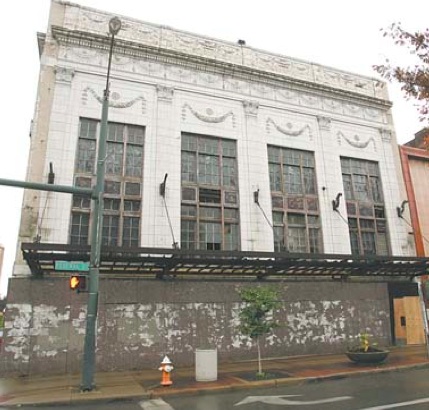Project will collect memories of decaying Youngstown theater
By GUY D’ASTOLFO

The dilapidated and boarded-up Paramount Theater building, as it appears today.
YOUNGSTOWN
The Paramount Theater holds a lot of memories.
The now-dilapidated downtown building was once a showplace of entertainment. Opened in 1918 as the Liberty Theater, the 1,700-seat venue offered silent movies and vaudeville acts in its early days. It was sold to Paramount Pictures in 1929, which renamed it and turned it into a movie palace.
The theater at West Federal and North Hazel streets closed in 1976 and has been deteriorating ever since. It is now beyond repair and awaits the wrecking ball.
Plans call for the edifice’s stately terra cotta facade to be saved and turned into the focal point of an outdoor performance space and parklet.
The facade will pay silent homage to the once-grand theater.
But the McDonough Museum of Art wants to do more than that. It wants to keep memories of the theater alive forever.
The museum has mounted what it calls the Paramount Oral History Project. It is seeking people who frequented the theater, as workers, patrons or entertainers, to share their memories in interviews that will be recorded by a camera crew and turned into a DVD.
The film will be part of an exhibit on the theater that will run from Jan. 13 to Feb. 2 at the McDonough, which is on Wick Avenue on the campus of Youngstown State University.
People who want to share their memories are asked to call the museum at 330-941-1400 to schedule an interview. Appointments are available between 11 a.m. and 4 p.m. Nov. 12 and Nov. 19. Callers will be asked to leave an email or postal address so that a questionnaire can be sent in advance of the interview, which will be conducted by YSU students.
“We are hoping to hear from anyone who has a story to tell from their experiences connected to the theater, from the heyday to just before it closed,” said Leslie Brothers, director of the McDonough.
Because senior citizens will have the furthest recall, nursing homes and assisted living facilities are being contacted. The film crew is wiling to tape on location for people who cannot come to the museum, said Brothers.
All of the interviews will be edited and turned into a DVD that will be screened in a gallery at the McDonough. Each interviewee will receive a copy, as will anyone who donates at least $20 to the project.
After the exhibition closes Feb. 3, the museum hopes to screen it in other public spaces in the Valley.
The purpose of the exhibition, said Brothers, is to recall the rich history of the theater and to preview, through a simulation within the museum space, the proposed design for the facade renovation and public square that will take its place.
“We want to share with the public why the project is important and how they can be a part of this downtown community redevelopment effort,” she said.
 43
43
